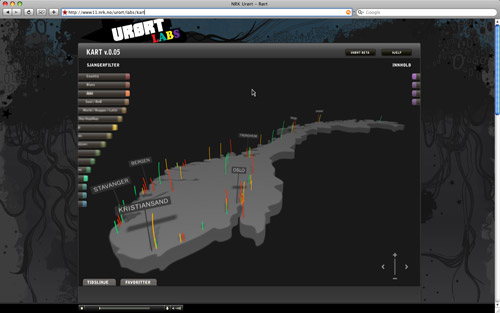conference
To be presented: Social Navimation
 |
I will present a full peer-reviewed paper on the Nordic Design Research conference NORDES’09: Engaging Artefacts, which will take place in Oslo in the end of August this year. The paper is called ‘Social Navimation: Engaging Interfaces in Social Media’, and explores how visually dynamic interfaces can enhance social media applications. This potential is investigated through experimental design production, followed by a textual analysis of the resulting interface prototypes. The term ‘social navimation’ is introduced and applied in the analysis, in which I investigate how semiotic resources from navimation are connected to features of social media. Hopefully, the paper will be of interest for both theory and practice of interface and interaction design, and new media studies in general.
UPDATE: The conference program and all papers are now available here. Download the full paper: Social Navimation: Engaging Interfaces in Social Media (PDF).
UPDATE 2: See the presentation.
Conference: Multimodality and Learning in London
Andrew Morrison and myself did a presentation at the conference Multimodality and Learning: New Perspectives on Knowledge, Representation and Communication, held at the Centre for Multimodal Research (Institute for Education at the University of London) 19-20 June this year. The aim of the conference was to explore multimodal perspectives on learning.
The conference was just right for my project at that time, as we got to present some core ideas and get feedback. In addition, it was great to get introduced to a specific and relevant field of research, meet and listen to professional researchers. Keynote speakers were Charles Goodwin, Jay Lemke, Roger Saljo, and Gunther Kress.
Our presentation: The times are a-changing in the interface
There were unfortunately no written papers for the conference, but here is the abstract:
The times are a-changing in the interface
Digital media and technologies play a major role in formal and informal learning contexts. They have been widely studied in socio-cultural approaches to mediated meaning making. Little attention has been given to the interface as part of social semiotic production, mediation, analysis and communication. Interface design has tended to be framed within approaches Human Computer Interaction that have typically addressed structural and functional issues. Digital interfaces have seldom been cast as textual and mediational components in a wider social semiotics even in studies in multimodal discourse (spanning areas such as video concordancing, museum design and dynamic typography).
First, we situate research on interface design in relation to a wider notion of communication design informed by social semiotic approaches to mediated communication (Kress & van Leeuwen 2001, Jewitt 2005). We further connect these works to ones in ‘new media studies’ where interface design has been cast as part of changing narrative, rhetorical, expressive and expository discourses. We relate such approaches to the notion of ‘movement in the interface’ (Skjulstad & Morrison 2005). This notion was developed on the basis of practice-based design and educational inquiry into dance and technology. It was applied in the design of an interface to mediate multilevel perspectives with a focus on video. Core components of dynamic interfaces were identified. We relate these components to recent developments in spatio-temporal innovations in interfaces (Lemke 2005, Skjulstad 2007) on the Web and on mobile phones.
Second, we introduce the concept navimation to characterise developments in the interface that blend navigation with animation. We apply this to a selection of websites from a body of almost 100 examples. Using methods from social semiotic multimodal textual analysis, we examine these examples with reference to features incorporated from film, animation and hypertext studies. Screengrabs are included in this analysis.
Third, we argue that approaches to multimodal multiliteracies need to anticipate developments in interface design that include spatio-temporal elements.
The times are a-changing in the interface.
References:
Kress, G. & van Leeuwen, T. (2001). Multimodal Discourse: the Modes and Media of Contemporary Communication.
Jewitt, C. (2005). Technology, Literacy, Learning: A Multimodal Approach.
Skjulstad, S & Morrison, A. (2005). ‘Movement in the interface’. Computers & Composition. Vol. 22, No. 4. 413-433.
Lemke, J. (2005). ‘Place, pace, and meaning: multimedia chronotopes’. In Norris, S. & Jones, R.. (Eds). Discourse in Action: Introducing Mediated Discourse Analysis.
Skjulstad, S. (2007). ‘Motion graphics and communication design on the web’. Journal of Media Practice.
Websites we looked at in the presentation, all employing navimation:
http://www.xrs.pl
http://www.thewhalehunt.com/whalehunt.html
http://www.6pli.com/
http://www.leoburnett.com
http://www.piclens.com
http://www.nike.com/nikeacg/index-en.html
Search
Recent posts
- SpotTrack: Award for Design Excellence
- VizBox Bergen og årets geogründer
- Fulbright report: six months at the School of Cinematic Arts in Los Angeles
- The VizBox Experiments
- TopoBox: exploring a tangible dataviz platform
- Norway in 3D part I: from DEM to 3D surface
- Using visualization for understanding survey data
- Story kicking big data
- Fulbright project: Dynamic Information Visualization
- Visiting Fulbright scholar at USC in Los Angeles
- (E)motional design paper at DANDE2012
- 3,5 års arbeid på 6 minutt og 40 sekund
- PhD thesis online
- New video: Kinetic Interface Design
- Presentasjon: Skisser utanfor boksen